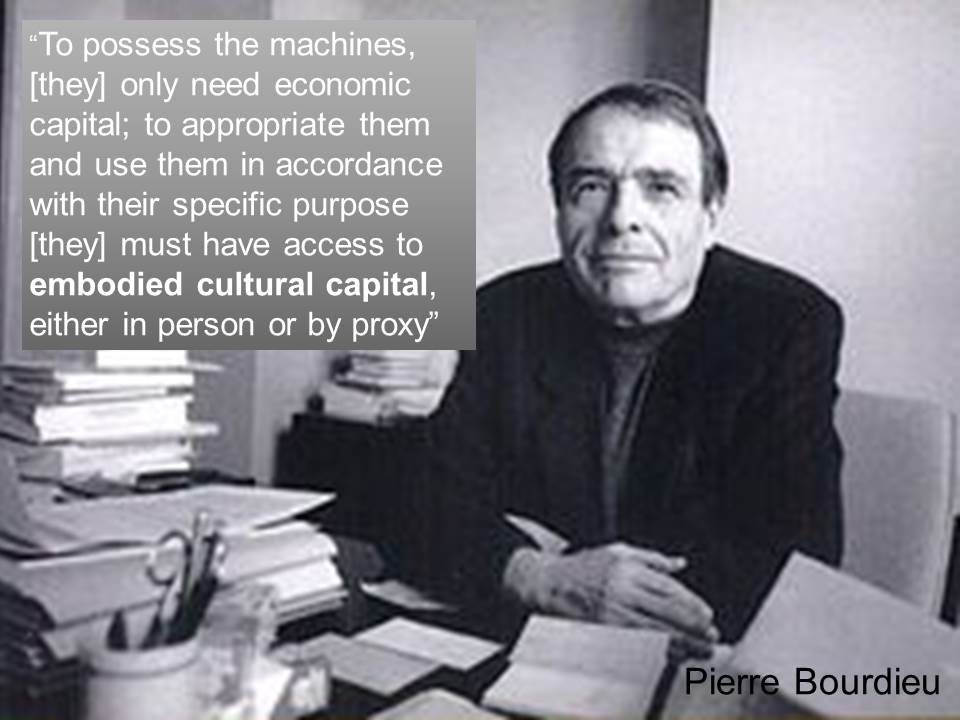This text is a scripted version of the video I created on my take of teaching and learning online – Part 1. Through this resource I highlight some of the concepts that underpin my understanding of digital spaces and digital practices and how they can be appropriated for teaching and learning in the context of Higher Education. In part 2 I will outline some ideas and examples of how we can link theory to practice, which in this case can also mean to transfer as well as transform practices observed on the digital sphere into digital learning activities.
Understanding digital practices
In the last 20 years we have gone through a massive digital transformation that has inevitably shaped our relationship with information and technology as well as our understanding of literacy. For example, the nature of digital presence and online participation has implied that individuals not only act as information consumers, but also have the opportunity to be(come) content producers (Figueiredo, 2005; 2006). Digital (cultural) production is supposedly “open to all”, even though inequalities persist and are exacerbated online, in part because of skill sets that enable individuals to perceive the educational value of digital technologies and the spaces it creates (see, for example, van Deursen and Van Sijk, 2014; Schradie, 2011). Being literate in the face to digital transformations relies heavily on the understanding of digital cultural practices as our relationship with technology becomes a habit(us) that pervades many everyday activities.
Making sense of digital Cultures
Digital technology has significantly impacted the way people communicate, work, learn and socialise. Henry Jenkins (2006) appraises this phenomenon through the concept of digital participatory culture that enables:
- Creation and sharing (of content, information, knowledge and/or artefacts that convey meaning to the user/the learner as well as their interlocutors/ peers)
- Contribution (of information and knowledge as a form of establishing one’s digital presence, which in turn is validated by the contributions of others
- Social connections (showing the value of fostering learning relationships within and beyond immediate learning groups/communities/networks as a form of cross fertilization of ideas)
- Mentorship (as members with different skills and levels of expertise pass along knowledge and model practices that can be taken on as well as transformed by other individuals)
These four key elements can be translated into four types of practice:
- Creative expressions (digital artefacts of diverse kinds)
- Collaborative activities (derived from engagement in online spaces)
- Social affiliations (as a form of fostering networks meaningful to one’s development)
- Sharing (of content that is produced or regarded as relevant to collective intelligence)
Critical digital literacies
In the cultivation of digital practices, individuals acquire literacies essential to their digital engagement and participation, but these literacies should not only concern instrumental skills, i.e., accessing and using digital tools, navigating and finding useful information, but also comprise forms of communicative competences that allow individuals to enter and establish themselves in digital cultural spaces in more active ways. From this perspective we can try to rescue the original goal of the web as a space of shared intersubjectivity. Applying an Habermasian perspective to this matter (see Habermas, 1986), we could say that online spaces are ripe for communicative action, where teaching and learning is recognised as a dialogical process that values the voices of all of those involved. The communicative process places emphasis not only on the knowledge content of learning, but also and above all on the social and cultural processes that enable it. Hence, in online spaces, just as in face-to-face environments, the negotiation of meaning becomes a core aspect of the teaching and learning. Drawing again on Habermas and his followers (see for example, Huttunen and Murphy, 2012; Murphy and Fleming, 2009; Whitworth, 2006), negotiated meaning can be encouraged through reasoned justifications and arguments as a form of promoting learning experiences underpinned by understandings of social justice. In essence, everyone taking part in such learning experiences can and should exercise their voices in informed ways.
Educators and learners: roles and responsibilities
Understanding critical digital literacies from the prim of communicative action opens the space to revisit the roles and responsibilities of educators and learners and how these are embodied as part of their respective identities.
Digital practices ask for dynamic approaches to teaching and learning where power relationships are foreseen to take second stage by virtue of encouraging collaborative effort. Thus, it is important to resist the temptation to imagine the teaching and learning relationship as divisive, with educators taking the role of knowledge producer and learners becoming recipients of information. This would be at odds with the principles of a digital participatory culture we would aim to instil as part of the learning environment as well as the critical literacies individuals would be expected to cultivate online.
Such strict teaching and learning relationships belong to outdated understandings of education, which, I am sure, the reader will most likely not endorse. However, I find it necessary to highlight it so that education can consciously move away from a banking model of education (Freire, 1970) that is more often than not practised through the commercialisation of e-learning. What I want to propose instead then is that online educators be more concerned with the engineering of learning contexts rather than content. In this vein, educators’ essential role is to ‘animate’ the learning environment by posing challenges and designing activities through which learners can create knowledge and develop their own understandings.
This then implies that learners are also invited to take on an active and visible role as part of their learning. In a higher education setting this may include making active use of time allocated for independent learning as a strategy to contribute to the challenges posed as well as to create visible learning routines as online presence is manifested through active contribution and participation.
Additionally, learning ‘to be’ in online spaces is a crucial element of both teaching and learning that can be progressively acquired through practice. Here both educators and learners will have experiences to share and create.
Learning ethos
In embodying one’s online teaching and learning roles, it is also important to discuss the learning ethos we want to co-create as part of participating online. Here I draw inspiration from the work of Brown and Adler (2008):
- Interdependence: underpinning the idea that learning is a shared construction of knowledge. This does not however mean that learning happens exclusively through interaction with others, but rather that the construction of ideas can acquire further relevance when shared with others
- Generosity: learning online is often epitomised by a spirit of sharing and manifested by individual contributions to joint debates instigated by fellow learners and educators
- Dynamic environment: where different forms of participation are welcomed and taken into account
- Transformation: that happens when learning generates changes in the way we think, act and practise. But, as the old saying goes, we only get out what we put in and transformative learning relies on individuals’ persistent interest in developing their own understandings of the worlds and practices they have set to explore.
It could thus be argued that online teaching and learning aims to follow Paulo Freire’s (1970) lead in ‘transforming transfers of information into a real act of knowing’ (p. 43) which can be realised through ‘unhampered participation in a meaningful setting. [Afterall,] most people learn best by being “with it’ (Illch, 1971, p. 44), hence a greater emphasis on developing learning contexts rather than content, precisely because content is expected to emerge from learners’ participation and contributions.
Ultimately, I have tried to make a case for learning as a key social practice whilst regarding digital technologies as spaces that can house such activities.
References:
Brown, J. S., & Adler, R. P. (2008). Minds on Fire: Open Education, the Long Tail, and Learning 2.0. EDUCAUSE Review, 43(1), 16.
Figueiredo, António Dias de. (2005). Learning Contexts: A Blueprint for Research. Interactive Educational Multimedia, 11, 127–139.
Figueiredo, Antonio Dias de. (2006). Context and Learning: A Philosophical Framework. https://www.academia.edu/162856/Context_and_Learning_A_Philosophical_Framework
Freire, P. (1970). Pedagogy of the Oppressed. Penguin Classics.
Habermas, J. (1986). Theory of Communicative Action, Volume 1: Reason and the Rationalization of Society: Reason and the Rationalization of Society Vol 1 (New Ed edition). Polity.
Huttunen, R., & Murphy, M. (2012). Discourse and Recognition as Normative Grounds for Radical Pedagogy: Habermasian and Honnethian Ethics in the Context of Education. Studies in Philosophy and Education, 31(2), 137–152. https://doi.org/10.1007/s11217-012-9285-8
Illich, I. (1971). Deschooling Society (New edition edition). Marion Boyars Publishers Ltd.
Jenkins, H. (2006). Confronting the Challenges of Participatory Culture: Media Education for the 21st Century. An Occasional Paper on Digital Media and Learning. John D. https://eric.ed.gov/?id=ED536086
Murphy, M., & Fleming, T. (Eds.). (2009). Habermas, Critical Theory and Education (1 edition). Routledge.
Schradie, J. (2011). The digital production gap: The digital divide and Web 2.0 collide. Poetics, 39(2), 145–168. https://doi.org/10.1016/j.poetic.2011.02.003
Whitworth, A. (2006). Communicative competence in the information age: Towards a critical theory of information literacy education. Innovation in Teaching and Learning in Information and Computer Sciences, 5(1), 1–13. https://doi.org/10.11120/ital.2006.05010007











Why do we have to apply the jargon used by Freire and Habermas to theorise on-line learning? The point that here is of importance, at least individually, related to social alienation. E-learning would be better interpreted through both the lens of sociologiy and psychology. Besides, I would like to see online transference of knowledge through Skinner’s Step by step way which is simpler and applicable in small steps. E-learning is still a vital illusion, an electronic illusion which is gradually taking the role of physical classrooms. It is an illusion for me at least.
All these technologies can perfectly complement the learning process, but it is impossible to fully replace it, because you need live communication that is most fruitful in learning.